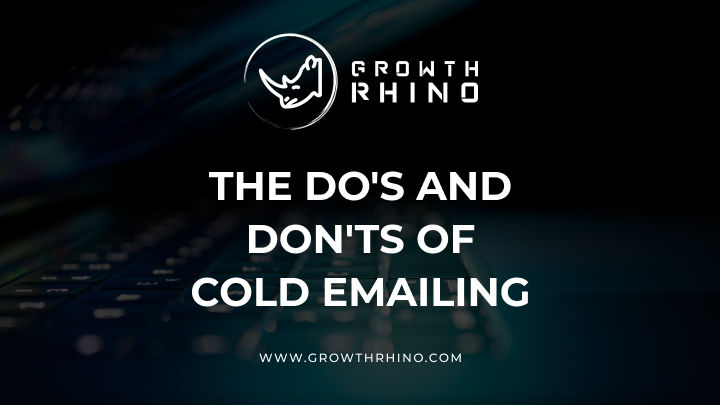
Cold emailing can be a powerful tool for reaching out to potential clients, partners, or industry contacts. However, it's important to approach this type of outreach with care and consideration, as it can easily come across as spammy or pushy if not done correctly. Here are some do's and don'ts to keep in mind when it comes to cold emailing:
DO:
Do: Research the recipient
To maximize the effectiveness of your cold emails, researching the recipient is vital. With a few clicks on their website or related search queries, you can quickly understand who you're reaching out to and what they might be interested in or have a need for.
Specifically, take a look at their LinkedIn profile to learn about any professional accomplishments or events that could offer insight into their goals and objectives. Knowing all this information helps give your cold email more context, setting the foundation for an engaging conversation and potentially lasting business relationship.
Do: Personalize the email
Writing an effective cold email isn't a one-size-fits-all solution. The key to putting together a message that stands out is personalizing it for the recipient—this means using their name, mentioning something you might have in common, like a mutual contact, or simply explaining why you are reaching out to them.
Doing this goes beyond including standard details like their first name and requires taking the extra step of ensuring the email's content resonates with who they are on an individual level. Including personalized touches will make your emails more engaging and make readers feel like your message was written with them in mind.
Do: Keep the email brief and to the point
Staying brief when cold emailing is key - nobody wants to sink time into an email from someone they don't know. Remember to keep your message concise and focused on the point at hand when reaching out.
That way, you stand the best chance of catching and holding the reader's attention while ensuring the message is still effective and tailored toward the subject you are emailing about. And getting right to it goes a long way in showing respect for someone's time. After all, everybody's busy!
Do: Include a call to action
Cold emailing can be a powerful way to reach out and create a meaningful connection with another person. However, to thrust your cold emails into success, you will need to include a call to action -- something that you would like the recipient to do as a direct result of reading your message.
Generally speaking, your call to action should reflect the overall purpose of the email. So, if it's an introductory email, ask them if they can schedule a quick phone chat. If it's more business-oriented, you might request that they meet up with you for coffee so you can discuss possibilities further.
No matter the exact context, ensure your cold email contains a clear call to action so everything is clear about what happens next!
Do: Proofread and edit
No one wants to read a cold email from someone with poor spelling or grammar. Good grammar signals that you are professional and savvy, so always take the time to proofread and edit your emails. A little bit of effort can go a long way in making a great impression and ensuring that your messages are read.
Double-check that everything is correct, including names, titles, and other critical details regarding the recipient. Doing so will ensure that your message stands out and gets noticed!

DON'T:
Don't: Use a generic subject line
Crafting the perfect subject line for a cold email is like writing a great headline for an article -- it needs to grab the recipient's attention in a few words! If you don't take the time to make it relevant, your email may be ignored or, worse, rapidly deleted.
Creating a unique and catchy subject line might feel intimidating, but it can help you stand out from all the other emails your contact is receiving. A short and descriptive subject line that captures what the content of your email is about can increase conversion rates significantly. Put some thought into yours and watch those open rates soar!
Don't: Use a fake or impersonal greeting
As the saying goes, first impressions matter - and the same is definitely factual for cold emails. Why spend the time crafting a well-written email if you start with a generic greeting? To make a lasting impression and set yourself apart from all other cold emails in their inbox, you should always include a personalized and warm greeting.
Take the time to research or double-check the recipient's name, address them by it directly as "Hi [Name]," or use a more casual and friendly greeting like "Hey [Name]." Your recipients will appreciate the extra effort and be much more likely to read your email with an open mind.
Don't: Use too many exclamation points or all caps
When crafting the right message, one thing that you should avoid is the use of exclamation points and all caps. This kind of writing comes off as unprofessional and might do more harm than good in terms of connecting with someone.
So instead of trying to grab attention with flashy writing tactics, think about the tone you want to convey and the impression you'd like them to have when they get your email -- because that will make all the difference!
Don't: Include attachments without permission
Cold emailing is often a tricky affair, presenting the challenge of getting your message across without offending someone. One crucial tip to remember is always asking permission before including any attachments in your emails. Otherwise, it could be interpreted as an unwelcome security risk.
Doing so shows respect to the recipient, and it avoids any potential misunderstanding you may have regarding their expectations for the email and any materials attached. Taking this one extra step will help ensure your cold emails are well received and get positive responses.

Conclusions
In conclusion, cold emailing can be an effective way to reach out to potential clients or partners, but it's essential to approach it with care and consideration. By doing your research, personalizing the email, keeping it brief and to the point, including a call to action, and proofreading and editing, you can increase your chances of success.
On the other hand, avoid using a generic or misleading subject line, fake or impersonal greetings, too many exclamation points or all caps, and attaching files without permission to increase your chances of success. With a well-crafted cold email, you can increase your chances of getting noticed and making the right connection. Good luck!
